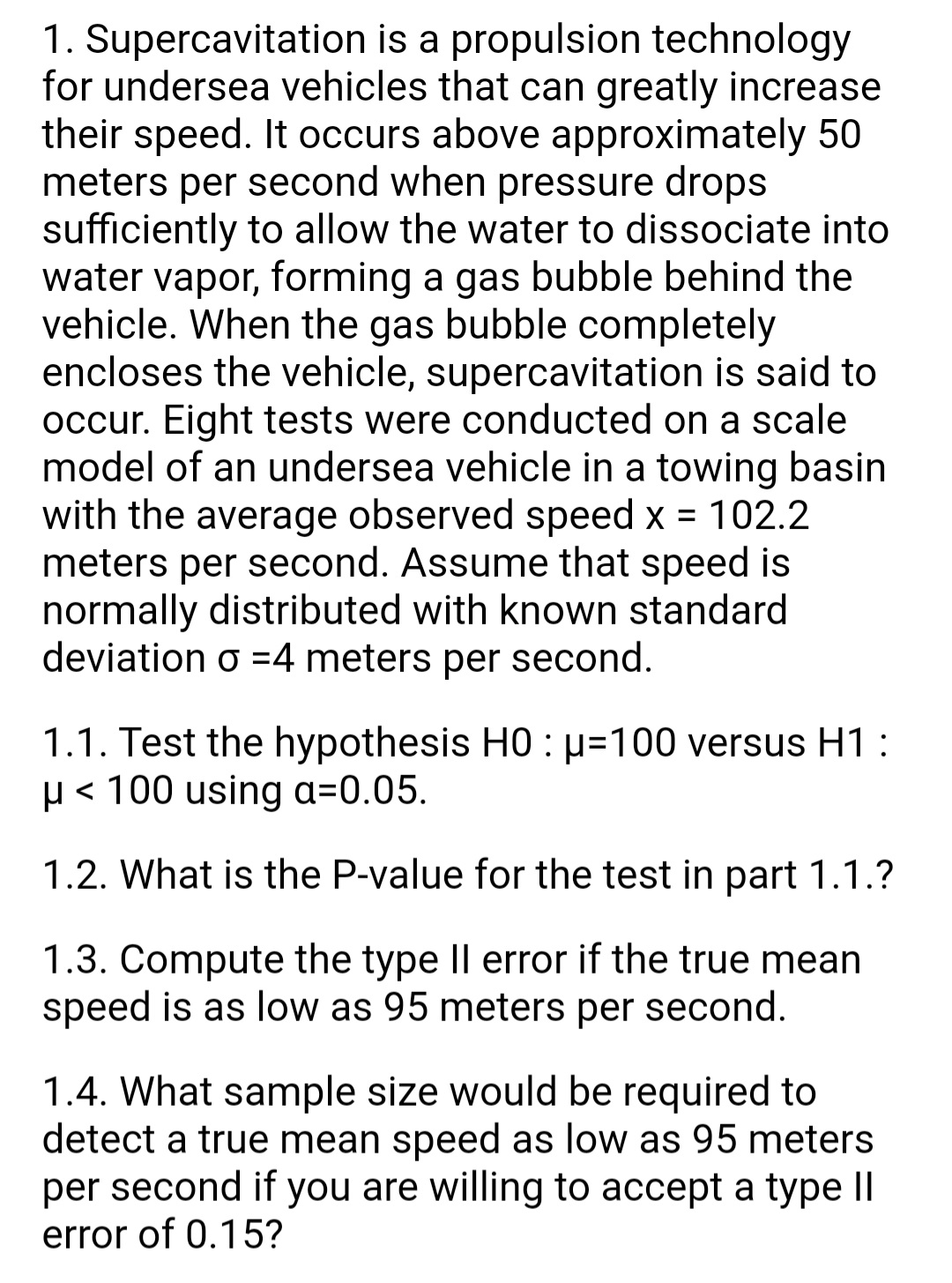1. Supercavitation is a propulsion technology for undersea vehicles that can greatly increase their speed. It occurs above approximately 50 meters per second when pressure drops sufficiently to allow the water to dissociate into water vapor, forming a gas bubble behind the vehicle. When the gas bubble completely encloses the vehicle, supercavitation is said to occur. Eight tests were conducted on a scale model of an undersea vehicle in a towing basin with the average observed speed x = 102.2 meters per second. Assume that speed is normally distributed with known standard deviation o =4 meters per second. %3D 1.1. Test the hypothesis H0 :p=100 versus H1 : H< 100 using a=0.05. 1.2. What is the P-value for the test in part 1.1.? 1.3. Compute the type II error if the true mean speed is as low as 95 meters per second. 1.4. What sample size would be required to detect a true mean speed as low as 95 meters per second if you are willing to accept a type II error of 0.15?
1. Supercavitation is a propulsion technology for undersea vehicles that can greatly increase their speed. It occurs above approximately 50 meters per second when pressure drops sufficiently to allow the water to dissociate into water vapor, forming a gas bubble behind the vehicle. When the gas bubble completely encloses the vehicle, supercavitation is said to occur. Eight tests were conducted on a scale model of an undersea vehicle in a towing basin with the average observed speed x = 102.2 meters per second. Assume that speed is normally distributed with known standard deviation o =4 meters per second. %3D 1.1. Test the hypothesis H0 :p=100 versus H1 : H< 100 using a=0.05. 1.2. What is the P-value for the test in part 1.1.? 1.3. Compute the type II error if the true mean speed is as low as 95 meters per second. 1.4. What sample size would be required to detect a true mean speed as low as 95 meters per second if you are willing to accept a type II error of 0.15?
Mathematics For Machine Technology
8th Edition
ISBN:9781337798310
Author:Peterson, John.
Publisher:Peterson, John.
Chapter16: Table Of Decimal Equivalents And Combined Operations Of Decimal Fractions
Section: Chapter Questions
Problem 34A: A stamped sheet steel plate is shown in Figure 164. Compute dimensions AF to 3 decimal places. All...
Related questions
Question
1.4) ONLY

Transcribed Image Text:1. Supercavitation is a propulsion technology
for undersea vehicles that can greatly increase
their speed. It occurs above approximately 50
meters per second when pressure drops
sufficiently to allow the water to dissociate into
water vapor, forming a gas bubble behind the
vehicle. When the gas bubble completely
encloses the vehicle, supercavitation is said to
occur. Eight tests were conducted on a scale
model of an undersea vehicle in a towing basin
with the average observed speed x = 102.2
meters per second. Assume that speed is
normally distributed with known standard
deviation o =4 meters per second.
1.1. Test the hypothesis H0 : µ=100 versus H1 :
u< 100 using a=0.05.
1.2. What is the P-value for the test in part 1.1.?
1.3. Compute the type II error if the true mean
speed is as low as 95 meters per second.
1.4. What sample size would be required to
detect a true mean speed as low as 95 meters
per second if you are willing to accept a type II
error of 0.15?
Expert Solution
This question has been solved!
Explore an expertly crafted, step-by-step solution for a thorough understanding of key concepts.
This is a popular solution!
Trending now
This is a popular solution!
Step by step
Solved in 2 steps with 2 images

Recommended textbooks for you

Mathematics For Machine Technology
Advanced Math
ISBN:
9781337798310
Author:
Peterson, John.
Publisher:
Cengage Learning,

Functions and Change: A Modeling Approach to Coll…
Algebra
ISBN:
9781337111348
Author:
Bruce Crauder, Benny Evans, Alan Noell
Publisher:
Cengage Learning

Algebra & Trigonometry with Analytic Geometry
Algebra
ISBN:
9781133382119
Author:
Swokowski
Publisher:
Cengage

Mathematics For Machine Technology
Advanced Math
ISBN:
9781337798310
Author:
Peterson, John.
Publisher:
Cengage Learning,

Functions and Change: A Modeling Approach to Coll…
Algebra
ISBN:
9781337111348
Author:
Bruce Crauder, Benny Evans, Alan Noell
Publisher:
Cengage Learning

Algebra & Trigonometry with Analytic Geometry
Algebra
ISBN:
9781133382119
Author:
Swokowski
Publisher:
Cengage

Linear Algebra: A Modern Introduction
Algebra
ISBN:
9781285463247
Author:
David Poole
Publisher:
Cengage Learning

Algebra: Structure And Method, Book 1
Algebra
ISBN:
9780395977224
Author:
Richard G. Brown, Mary P. Dolciani, Robert H. Sorgenfrey, William L. Cole
Publisher:
McDougal Littell

Trigonometry (MindTap Course List)
Trigonometry
ISBN:
9781337278461
Author:
Ron Larson
Publisher:
Cengage Learning